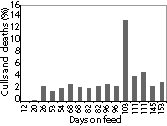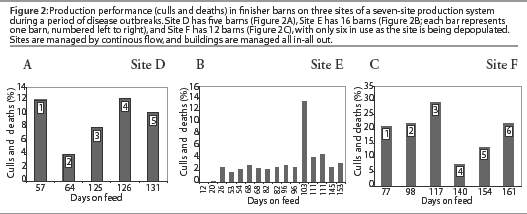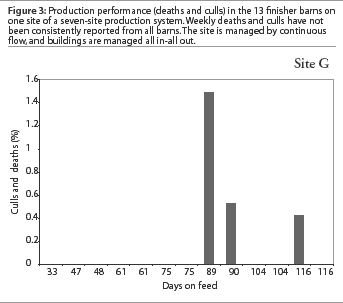What's your interpretation? |
Non refereed |
 Each bar on the graph shows the percentage of the original group of pigs that
has died or been culled (up to the day of the report) for one of 16 finisher buildings
on one site of a seven-site production system. What is the most likely reason for the
high percentage of culls and deaths in Barn 12?
Each bar on the graph shows the percentage of the original group of pigs that
has died or been culled (up to the day of the report) for one of 16 finisher buildings
on one site of a seven-site production system. What is the most likely reason for the
high percentage of culls and deaths in Barn 12?
Evaluating finisher groups using weekly mortality reports
Rick Tubbs, DVM, MS, MBA
Green River Swine Consultation, 3250 Nashville Road, Bowling Green, KY 42104; Tel: 270-843-9007; Fax: 270-781-5278; E-mail: rtubbs@earthlink.net.
Tubbs R. Evaluating finisher groups using weekly mortality reports. J Swine Health Prod. 2003;11(4):210-211.
Close-out reports are historical data by the time they are generated. Weekly mortality reports may be used to evaluate finisher groups while the groups are in progress rather than after group close-outs have been completed. The following series of graphs (Figures 1 to 3) for a seven-site production system (Sites A through G) shows weekly mortality by building on each site, ie, the percentage of the original group that has died or been culled up to the day of the report. The sites have continuous flow management, with each building (1000-head capacity) managed all in-all out. This series of graphs represents a range of production performance commonly seen on finishing sites. The extremely high percentages of culls and deaths are almost invariably due to the effects of infectious diseases.
"Normal" production
Site A (Figure 1A) is filled with pigs negative for porcine reproductive and respiratory syndrome (PRRS) and Mycoplasma hyopneumoniae (M hyo). Performance has been good but not outstanding. Performance in Barn 4 has been somewhat disappointing, but not due to any infectious disease.
Site B (Figure 1B) is another site filled with PRRS-negative, M hyo-negative pigs. Growth and feed efficiency performance on this site have been outstanding.
Site C (Figure 1C) is a PRRS-negative, M hyo-negative site with good performance for culls and deaths and growth and feed efficiency.
Disease outbreaks
On Site D (Figure 2A), the three barns with the oldest pigs were filled from a start-up gilt herd producing PRRS-negative, Mhyo-negative pigs. Shortly after pigs were placed in the finisher, there was a severe outbreak of Haemophilus parasuis. Treatment was begun on the affected pigs and pigs at the nursery site were vaccinated. Because of a gap in production, pigs were purchased from a reported PRRS-negative source and placed in the remaining two barns. These pigs subsequently developed clinical PRRS, infecting the entire site and inflicting another round of mortality. At this point, culls and deaths appear to have abated.

Site E (Figure 2B) is a 16-barn site filled with pigs from a PRRS-negative, M hyo-vaccinated source. Culls and deaths on this site are normally less than 3%. Because of pig flow gaps, Barn 12 was filled with pigs from two different sources, with the second source being a recently repopulated, high-health gilt farm. Pigs from the high-health source developed clinical H parasuis infection shortly after being placed in the finisher; approximately 80% of the total deaths and culls have been from that source.
Site F (Figure 2C) is a 12-building site; however, six buildings are currently empty, as the site is being depopulated. The high mortality on this site is due to the chronic effects of PRRS and a myriad of secondary bacterial organisms. Pig-flow interruptions have not stopped transmission of PRRS from older to younger pigs, so it is in the process of being depopulated and will be filled with pigs from a different sow herd source in the future.
Data reporting error
Site G (Figure 3) is a 13-building site filled with PRRS-negative, M hyo-vaccinated pigs. Performance is normally good; however, not as good as the data presented. Zero percent mortality has been reported for ten of the 13 buildings. Production is not that good - the contract grower has not been reporting weekly deaths and culls on a routine basis.


